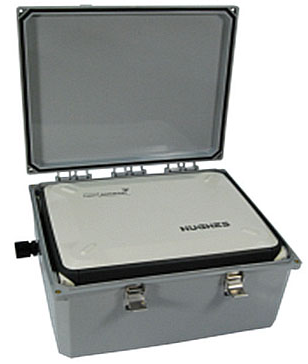The award-winning Broadband Global Area Network (BGAN) provides simultaneous voice and data globally. The network offers a range of guaranteed and on-demand IP streaming rates. The BGAN service is particularly useful for people working in areas with little or no terrestrial connectivity. Such people include live broadcast media, scientists looking for mineral deposits, and utility companies.
The Hughes 9201-M2M satellite IP terminal is a single-box, SCADA-ready, machine-to-machine terminal designed for use with BGAN services. Several features make the Hughes 9201-M2M ideal for use by the oil, gas, water, and utility industries. The terminal is easily packaged for continuous monitoring and control of remote sites, including well automation, pipeline monitoring, and utility SmartGrid such as SmartMeter backhaul, distribution automation, and substation SCADA. Additionally, the device provides immediate connectivity, is built to operate in extreme weather conditions. Additionally, because it is compact and versatile, the Hughes 9201-M2M is a highly secure and cost-effective solution for a wide range of sites handling kilobytes, megabytes, or gigabytes of data.
The 9201-M2M facilitates end-to-end IP communications supporting TCP and UDP traffic with essential IP SCADA benefits and features. These include:
- Auto Context Activation, which automatically establishes a data context with the network for the user device connected to the Hughes 9201-M2M. The user device can set up the automatic context with either a static local IP address or a dynamic DHCP local IP address;
- Auto On/Auto Power Cycle, which permits the Hughes 9201-M2M to automatically restore power to itself and turn back on if the site loses power or experiences a power interruption;
- Point Once, which provides the installer with a quick and easy method of installing, pointing, and activating the terminal. This feature prevents the need for a laptop in the field;
- 24/7 Keep Alive Link Supervision, which is designed to enable the Hughes 9201-M2M to supervise and maintain the data connection. The supervision occurs even when inactivity occurs for over 12 hours so that the customer’s remote terminal unit does not have to facilitate the task;
The IP Watchdog, which monitors the health of the data connection and takes various steps to keep it active. The terminal will initiate a reboot command to get back online if the data connection goes down and nothing is able to re-establish the connection; and The internal battery backup, which is an optional feature for backup power should the power at the site fail.
 These features make the Hughes 9201-M2M ideal for various oil, gas, and water applications. These applications include well data collection such as electronic flow management, pressure, and custody transfer data reading; remote monitoring and control of the compressor responsible for pushing high volumes of natural gas through the pipeline; and the transfer of critical and time-sensitive command and control instructions to downhole systems. Such features permit engineers to access sites remotely, without having to dispatch personnel, which preserves resources.
These features make the Hughes 9201-M2M ideal for various oil, gas, and water applications. These applications include well data collection such as electronic flow management, pressure, and custody transfer data reading; remote monitoring and control of the compressor responsible for pushing high volumes of natural gas through the pipeline; and the transfer of critical and time-sensitive command and control instructions to downhole systems. Such features permit engineers to access sites remotely, without having to dispatch personnel, which preserves resources.
Additionally, the Hughes 9201-M2M is currently being adopted and deployed for a variety of utility solutions. These include:
- An advanced metering infrastructure (AMI) Smart Meter Backhaul, by which thousands of residential and business wireless smart meters send usage data back to a collector point;
- Distribution Automation, which permits the Hughes 9201-M2M to be deployed at utility poles to enable control of SmartGrid infrastructure such as reclosers, fault indicators, and capacitor banks;
- Substation Communications, which dramatically enhance communication link availability at a substation so that the Hughes 9201-M2M can operate as the backup when the primary line fails;
- Disaster-Preparedness or Business Continuity Solutions, which permit use of the Hughes 9201-M2M for critical communications during the recovery period immediately following a catastrophic event that interrupts utility services.

